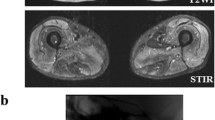Abstract
Muscle biopsy tissue from a patient with chronic hepatitis, who was hepatitis C virus (HCV) positive and showed slight weakness of the right arm and leg associated with increased serum creatine kinase levels, was studied using immunocytochemical and polymerase chain reaction (PCR) techniques. Muscle biopsy showed changes compatible with an inflammatory myopathy. Immunohistochemical studies included the use of monoclonal antibodies against human T lymphocytes, macrophages, immunoglobulins, major histocompatibility complex class I molecules (MHC-I), and the neoantigens of the terminal C5b-9 complement membrane attack complex (MAC). In addition to confirming the potential importance of cytotoxic T cells and MHC-I antigen expression in inducing muscle pathology, we demonstrated MAC deposition and the presence of HCV-RNA in the muscle of our patient, suggesting that direct involvement of the virus leading to complement activation might be important in inducing muscle damage.
Similar content being viewed by others
Author information
Authors and Affiliations
Additional information
Received: 30 November 1998 / Revised: 17 March, 29 June 1999 / Accepted: 30 June 1999
Rights and permissions
About this article
Cite this article
Villanova, M., Caudai, C., Sabatelli, P. et al. Hepatitis C virus infection and myositis: a polymerase chain reaction study. Acta Neuropathol 99, 271–276 (2000). https://doi.org/10.1007/PL00007437
Issue Date:
DOI: https://doi.org/10.1007/PL00007437



